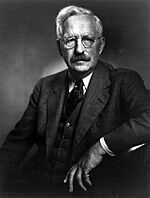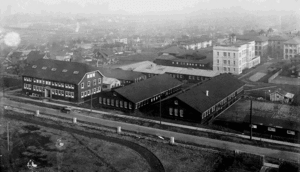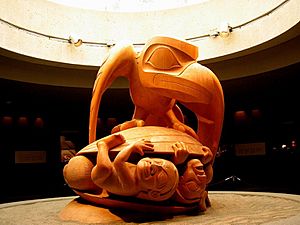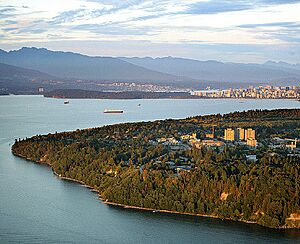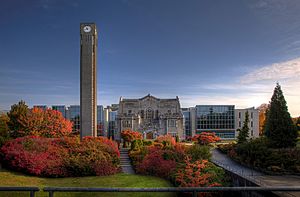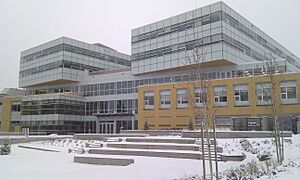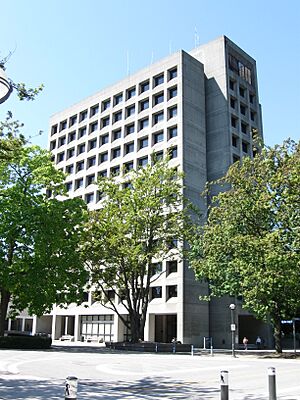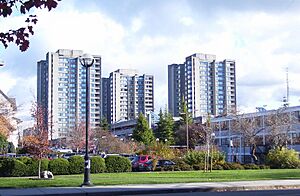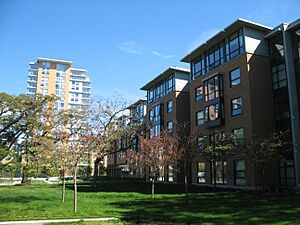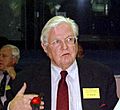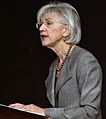University of British Columbia facts for kids
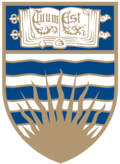
Coat of arms
|
|
| Motto |
Tuum Est (Latin)
|
|---|---|
|
Motto in English
|
"It is up to you" "It is yours" |
| Established | 1908 |
|
Academic affiliations
|
ACU, APRU, ASAIHL, Universities Canada, U15 |
| Endowment | CA$3.0 billion (2024) |
| Budget | CA$3.8 billion (2024) |
| Chancellor | Judy Rogers |
| President | Benoit-Antoine Bacon |
| Provost | Gage Averill (Vancouver) and Rehan Sadiq (Okanagan) |
|
Academic staff
|
5,696 (Vancouver) 600 (Okanagan) |
|
Administrative staff
|
10,647 (Vancouver) 835 (Okanagan) |
| Students | 66,266 |
| Undergraduates | 44,882 (Vancouver) 8,990 (Okanagan) |
| Postgraduates | 9,981 (Vancouver) 945 (Okanagan) |
| Location |
,
Canada
Kelowna, British Columbia, Canada
49°15′53″N 123°15′10″W / 49.26472°N 123.25278°W |
| Campus | Vancouver: 4.020 km2 (993 acres) Okanagan: 2.086 km2 (515 acres) |
| Language | English |
| Newspaper | The Ubyssey (Vancouver) The Phoenix News (Okanagan) |
| Colours | Blue and gold |
| Nickname | Thunderbirds (Vancouver) Heat (Okanagan) |
|
Sporting affiliations
|
NAIA, U Sports, CWUAA |
The University of British Columbia (UBC) is a major public research university in British Columbia, Canada. This means it is funded by the government and is a center for important discoveries and learning. It has two main campuses: one near Vancouver and another in Kelowna.
UBC is a powerhouse for research, with an annual budget of $893 million funding almost 10,000 projects. These projects help businesses, the government, and other organizations solve problems and create new things.
The Vancouver campus is on a large piece of land called Point Grey, right next to the city of Vancouver. It is home to TRIUMF, Canada's national lab for studying tiny particles, which has the world's largest cyclotron (a type of particle accelerator). UBC also has one of the largest research libraries in Canada, with over 8.3 million books and other items.
Many famous and successful people have been part of UBC. This includes eight Nobel Prize winners, 75 Rhodes scholars, and 231 Olympians. Three Canadian Prime Ministers—John Turner, Kim Campbell, and Justin Trudeau—are also UBC alumni.
History
How UBC Began
The University shall... provide for Such instruction in all branches of liberal education as may enable students to become proficient in... science, commerce, arts, literature, law, medicine, and all other branches of knowledge
The idea for a university in British Columbia started back in 1877. But for a long time, people couldn't agree on where to build it. Finally, in 1908, the British Columbia University Act officially created the university.
Before UBC became its own university, it started as a small college connected to McGill University in Montreal. From 1906 to 1915, it was called McGill BC. It offered the first few years of a university degree.
In 1910, Point Grey was chosen as the location for the new university. But when World War I started in 1914, building plans had to be put on hold. The university opened on September 30, 1915, at a temporary site in Vancouver's Fairview neighborhood. In 1916, UBC awarded its first degrees.
The Great Trek to Point Grey
By 1922, the university was growing fast, but it was still in its small, temporary buildings. Students got tired of waiting for the new campus to be built. They organized a huge march through the streets of Vancouver to get public support. This event is now famously known as "The Great Trek."
The students collected 56,000 signatures on a petition. Their campaign worked! On September 22, 1925, classes finally began at the new Point Grey campus. At first, most of the buildings were just temporary huts, but it was a start.
The university faced tough times during the Great Depression and World War II. Money was tight, and many students and staff left to join the war. But after the war, thousands of veterans came to study at UBC. The university grew quickly, using old army camps for classrooms and housing. Many new, permanent buildings were constructed, including the War Memorial Gym, which was paid for mostly by students.
Modern Times
In 1971, Prime Minister Pierre Trudeau announced the creation of the Museum of Anthropology at UBC. The museum, designed by famous architect Arthur Erickson, opened in 1976 and is a major attraction.
UBC has continued to grow and raise money for new projects. A campaign called "Start an Evolution" raised over $1.6 billion. This money helps fund research, new buildings, and student scholarships.
In 2020, due to the COVID-19 pandemic, UBC held its first-ever virtual graduation ceremony for the class of 2020.
Campuses
Vancouver Campus
The main campus is at Point Grey, a beautiful spot with views of the mountains and the ocean. It is located on the traditional, ancestral, and unceded territory of the Musqueam people. The campus is so large that it is not officially part of the city of Vancouver. It has its own RCMP detachment.
The campus is famous for its beautiful gardens. The UBC Botanical Garden and Centre for Plant Research has over 8,000 different types of plants. The Nitobe Memorial Garden is a peaceful Japanese garden created to honor scholar Inazo Nitobe.
The campus also has the Chan Centre for the Performing Arts, which hosts concerts and shows. You might even recognize it from TV shows and movies!
Okanagan Campus
In 2005, UBC opened a second campus in Kelowna, called UBC Okanagan. It is located on the territory of the Syilx Okanagan Nation. This campus has grown quickly and now has over 10,000 students.
UBC Okanagan offers many programs, including arts, science, engineering, and nursing. It has also expanded with many new buildings for living, teaching, and research. A new downtown Kelowna building is under construction and is expected to be finished by 2027.
Libraries and Galleries
The UBC Library is the second-largest academic library in Canada. It has 7.8 million books and e-books. The main library building, the Irving K. Barber Learning Centre, is a mix of old and new architecture. It even has a robotic system to store and find books!
The library has some amazing collections. It has over 28,000 movie DVDs from the famous Videomatica store. It also owns a copy of the Kelmscott Chaucer, a very rare and beautiful book from 1896.
The Morris and Helen Belkin Art Gallery on campus has a collection of over 5,000 works of art. It shows art from today's artists and is a center for learning about art history.
Academics and Research
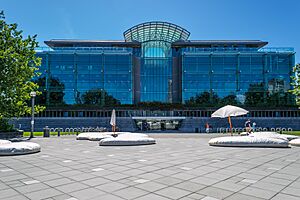
UBC is known around the world for its excellent education and research. It is often ranked as one of the top three universities in Canada and among the top 50 in the world.
Faculties and Schools
UBC is organized into "faculties" and "schools," which are like big departments for different subjects. The Vancouver campus has twelve faculties, and the Okanagan campus has seven. The largest is the Faculty of Arts. Other major ones include the Faculty of Science and the Sauder School of Business.
UBC also has a special program with Sciences Po, a top university in France. Students in this program spend two years in France and two years at UBC. They graduate with two degrees, one from each university.
| University rankings | |
|---|---|
| Global rankings | |
| ARWU World | 47 |
| QS World | 38 |
| Times World | 41 |
| Times Reputation | 36 |
| Times Employability | 36 |
| U.S News & World Report Global | 39 |
| Canadian rankings | |
| ARWU National | 2 |
| QS National | 3 |
| Times National | 2 |
| U.S News & World Report National | 2 |
| Maclean's Medical/Doctoral | 3 |
| Maclean's Reputation | 2 |
Important Research
UBC is a member of Universitas 21, a group of top research universities from around the world. The university receives hundreds of millions of dollars in research funding each year.
Some of the amazing research facilities at UBC include:
- TRIUMF: A world-class lab for particle and nuclear physics.
- The Peter Wall Institute for Advanced Studies: A place where scholars from different fields work together on big ideas.
- The UBC Farm: A 24-hectare farm on campus where students learn about sustainable agriculture. The farm sells its fresh, organic food at a market on Saturdays.
- The Stewart Blusson Quantum Matter Institute: A center for studying the strange and wonderful world of quantum materials.
Student Life
Life at UBC is more than just classes and studying. There are many clubs, sports, and events for students to enjoy.
Student Government
The Alma Mater Society (AMS) is the student union for undergraduates at the Vancouver campus. It represents students, provides services like health plans, and runs the student union building, called "The Nest." The Nest is a huge building with a performance center, art gallery, climbing wall, restaurants, and a pub.
Graduate students have their own group called the Graduate Student Society (GSS). At the Okanagan campus, the student union is called the UBCSUO.
Living on Campus
Over 10,000 students live on the Vancouver campus in residences, which are also called dorms. First-year students usually live in places like Totem Park or Place Vanier. Older students can live in apartment-style residences like the Walter Gage Towers.
In 2017, UBC opened Brock Commons Tallwood House, which was the tallest building in the world made from mass timber. This shows UBC's commitment to building in new and sustainable ways.
Sports and Traditions
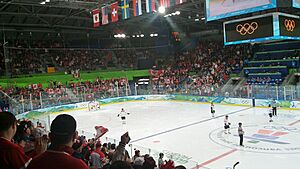
UBC's sports teams are called the Thunderbirds. They compete against other universities in Canada and the United States. The women's swimming team is especially successful, having won many national championships.
UBC has amazing sports facilities, including the Doug Mitchell Thunderbird Sports Centre, which was used for the 2010 Winter Olympics.
A fun tradition at UBC is Storm the Wall. It's a relay race where teams swim, sprint, bike, and run, finishing by climbing a 12-foot (3.7-meter) wall. Another big event is the Day of the Longboat, a huge canoe race held every fall.
Famous People from UBC
-
Justin Trudeau, Canada's 23rd Prime Minister
-
Kim Campbell, Canada's 19th Prime Minister and the first woman to hold the job
-
John Turner, Canada's 17th Prime Minister
-
Robert Mundell, Nobel Prize winner in Economics
-
Bertram Brockhouse, Nobel Prize winner in Physics
-
William Gibson, author who invented the term "cyberspace"
-
David Suzuki, famous scientist and environmentalist who was a professor at UBC
-
Beverley McLachlin, former Chief Justice of Canada
Many people who have studied or taught at UBC have become famous.
- Prime Ministers: Justin Trudeau, Kim Campbell, and John Turner all attended UBC.
- Nobel Prize Winners: Robert Mundell (Economics) and Bertram Brockhouse (Physics) were UBC graduates.
- Scientists and Activists: David Suzuki, a famous scientist and environmentalist, was a professor at UBC for many years.
- Astronauts: Bjarni Tryggvason graduated from UBC before flying into space with NASA.
- Artists and Writers: William Gibson, who came up with the word "cyberspace," and Jeff Wall, a famous artist, are both UBC alumni.
- Actors: Evangeline Lilly from the show Lost and Manny Jacinto from The Good Place both went to UBC.
Arms
See also
 In Spanish: Universidad de Columbia Británica para niños
In Spanish: Universidad de Columbia Británica para niños
- CITR-FM
- UBC Botanical Garden and Centre for Plant Research
- UBC Library
- UBC Okanagan
- University of Northern British Columbia
- List of Canadian universities by endowment


